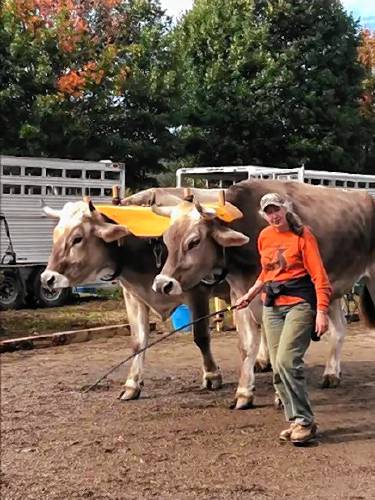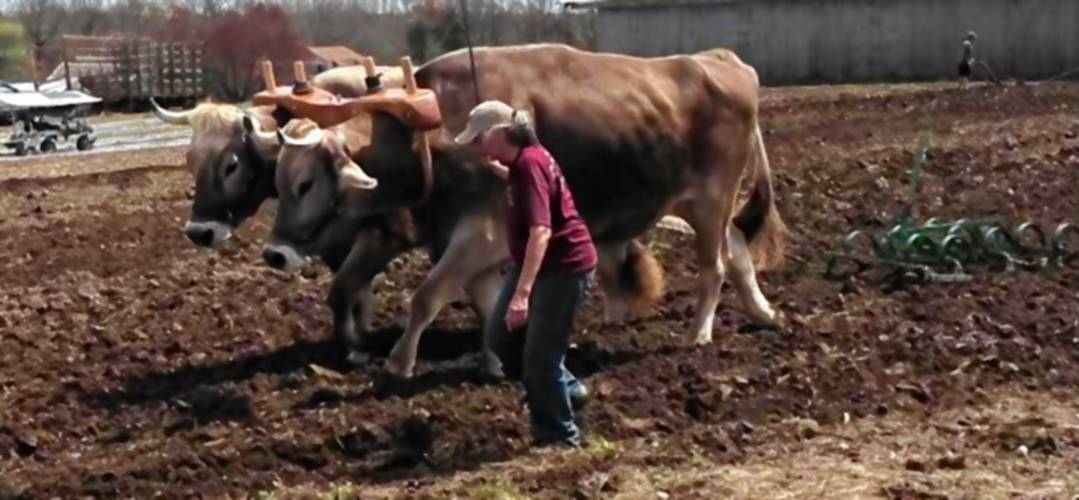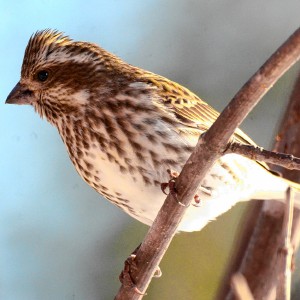Trainable, useful giants: Oxen coming to Shelburne event this weekend
| Published: 06-24-2024 12:06 PM |
When I was a kid, the barn in Saint-Germain-de-Grantham, Québec where my uncle milked 40 cows was a magical place. I spent hours with adorable kittens and ”lesfilles,” the placid gals whose milk fueled our family farm. Yet one thing made my blood run cold: being dared by one of my dozens of cousins to venture close to the shadowy corner where a cage housed “le taureau,” the bull. The massive, nose-ringed creature showed up in my nightmares, snorting and stomping his hooves.
And not for nothing: farmer Melanie Brundage, who’ll be in Shelburne this Saturday for an extraordinary agricultural demonstration, notes that “[cattle] bulls are traditionally nasty.” Females are prized for milk production, but other than being destined for dinner plates, the career trajectory of males is limited. If they can get onto a reproductive path, there’s some job security, but it doesn’t make bulls fun to be around.
Before writing this column, I knew only that oxen are enormous and good for hauling stuff. I wrongly assumed that they’re a species unto themselves, yet oxen are almost identical to the behemoth my uncle kept under lock and key. The biggest difference is testosterone: a bull is basically a sperm factory, whereas an ox is a castrated male bovine who – due to missing parts – knows how to chill. For centuries, oxen have helped with logging, sugaring, and other heavy-duty farm work, yet I never really considered them until receiving a notice from Fabric of Life, the Shelburne-based organization that garnered a brief mention in my June 18 column.
For those interested in meeting oxen and their trainers, everyone’s invited this Saturday, June 29 to the Fabric of Life headquarters, 80 Bassett Rd. in Shelburne, the family home of Becky Ashenden, who’s widely admired for her weaving school and prodigious musicianship. She’s also the founder and director of a dynamic local non-profit dedicated to preserving and passing on knowledge of traditional skills. Fabric of Life celebrates its tenth anniversary this year, so it’s a great time for folks to visit the farm for the first time, or for fans to return to a magical place.
On Saturday, Brundage will offer introductory remarks at 9 a.m. and demonstrations will take place around 10 a.m. At noon, visitors can partake in a buffet-style lunch — there’s no charge, but donations are welcomed. At 1 p.m., attendees can meet oxen and their teamsters; the event is slated to wrap up around 2 p.m. Folks are encouraged to bring lawn chairs or blankets, and for everyone’s safety and comfort, please leave pets at home.
The intro by Brundage will include history and basics about breeds commonly used for draft. A native of Natick, Brundage always felt like she was born in the wrong place. “Suburbia wasn’t a good fit for me,” she said. “I couldn’t wait to venture out.” And venture out she did, eventually marrying a farmer and settling in Douglas, located in south central Massachusetts.
Melanie’s husband, Scott, introduced her to cattle, and they had a friend whose oxen participated in competitions designed to test the ability to pull impressive loads. “Scott and his friends grew up in 4H [programs], immersed in agriculture,” said Brundage, “whereas I grew up without so much as a pet cat.” She’d always loved horses, though, and her parents provided her with riding lessons; following high school, Brundage lived on a horse farm.
After they’d built a barn on their land, the Brundages heard from a friend who’d come into possession of calves. “They’d been part of a petting zoo,” said Brundage, “and needed a home. Those calves became our first team of oxen, and that’s how I learned to work with cattle. Before that, all of my experience had been with horses and, in the horse world, experienced people aren’t generally paired with young horses. But cattle are different: I learned by doing, and could work safely with an instructional book held in one hand. Now, it seems like everything we do in our spare time revolves around oxen.” Brundage’s day job is working as a school nurse; she also spends time with grandkids, aged 4 and 9.
Article continues after...
Yesterday's Most Read Articles
Brundage emphasized that New England remains a locus of working oxen activity and skill. “We have some great mentors here,” she said, “and active 4H clubs. Oxen have stayed central to our region.” Her description of size is impressive; one of the Brundages’ oxen is 6 feet 4 inches at the shoulder and weighs about 3,000 pounds.
Working oxen wear a yoke, a simple wooden beam used to join animals, enabling them to pull on a load. Etymology fans, check this out: “yoke” derives from a Proto-Indo-European word, yugóm (join or unite), and is related to the word yoga. This root can be traced to many other languages including German (joch), Latin (iugum)Ancient Greek (zygon), Persian (yuğ), Sanskrit (yugá), and Lithuanian (jungas). But I digress.
Advantages of oxen over horses can include that wooden yokes tend to be more durable than leather harnesses; some trainers find that oxen are more docile than horses and capable of pulling heavier dead weights. The cost of oxen feed is lower than that of horses, and in some ways oxen possess greater hardiness.
The Brundages participate in many demonstrations, including at Old Sturbridge Village. “While there, we wear period costumes, display primitive skills, and enjoy the bustling community,” said Brundage. At Saturday’s event, attendees will learn why working oxen are making a comeback, and observe both adult and youth teamsters demonstrate a traditional form of draft power. Oxen and their handlers will negotiate an obstacle course, pull a stone boat, do some logging, and plow a garden plot so it can be planted with broom corn, pumpkins and sunflowers.
Also on hand with both oxen and Belgian draft horses will be Chesterfield residents Faith and Donnie Bisbee of Clay Hill Farm, who may be familiar faces for folks who’ve enjoyed wagon rides at various regional fairgrounds, including in Cummington, Heath and Greenfield. They’ve each worked with oxen since childhood. “Donnie started at age 6 or 7,” said Faith Bisbee. “Now our kids, Carson (13) and Brooke (11), each have their own oxen.” The Bisbee youngsters will also be on hand to share skills and knowledge on Saturday.
The Bisbee family helps run a 4H club called the Hilltown Misfits. “I’m in charge of the working steers,” said Faith. “That’s what we call young oxen.” She appreciates both draft horses and oxen: “They have different advantages. Oxen are slower moving and more easygoing. I like watching kids train them. Many people don’t know about oxen, so it’s fun to teach about them, and to compare how different animals plow: who’s faster, who’s more precise.”
Sara Davis, a Fabric of Life staff member whose family was featured in my June 18 column, noted that oxen can be particularly useful in the woods. “They’re great in environmentally sensitive terrain where you might not want to take a skidder or backhoe,” she said. “They’re good on smaller farms with rockier soil, which describes many New England farms.”
I don’t know why oxen weren’t used on the Québec farm where my mother (and seven generations before her) entered the world; my grandparents and their many children used horses to collect sap, plow fields, and drag logs until the 1950s, when they purchased a tractor. A longstanding family debate ensued about which was better, the four-leggeds or the gas-consuming vehicle? In any event, it gives me pause to know that the bull who scared the tar out of me could’ve been a much nicer guy and very useful with a little, um, alteration. As Brundage said, “An ox is a bull who’s been neutered and tutored.” I look forward to meeting the oxen at Saturday’s event, and hope to see you there!
For information about Fabric of Life events, including a July 7 sharpening workshop led by Shelby Howland, visit www.fabric-of-life.org.
Eveline MacDougall is the author of “Fiery Hope,” and a musician, artist and mom. To contact: eveline@amandlachorus.org / PO Box 223, Greenfield MA 01302








 Putting the students front and center: What can education can look like without high stakes testing?
Putting the students front and center: What can education can look like without high stakes testing? Sounds Local: He’ll play anything you want: Stephen Kellogg will perform an all-request show at Shea Theater, Dec. 19
Sounds Local: He’ll play anything you want: Stephen Kellogg will perform an all-request show at Shea Theater, Dec. 19 Speaking of Nature: Introducing the Birch Perch II: Making improvements to my bird observation venue
Speaking of Nature: Introducing the Birch Perch II: Making improvements to my bird observation venue Conversations over candy-making: Sharing beloved holiday food traditions
Conversations over candy-making: Sharing beloved holiday food traditions
